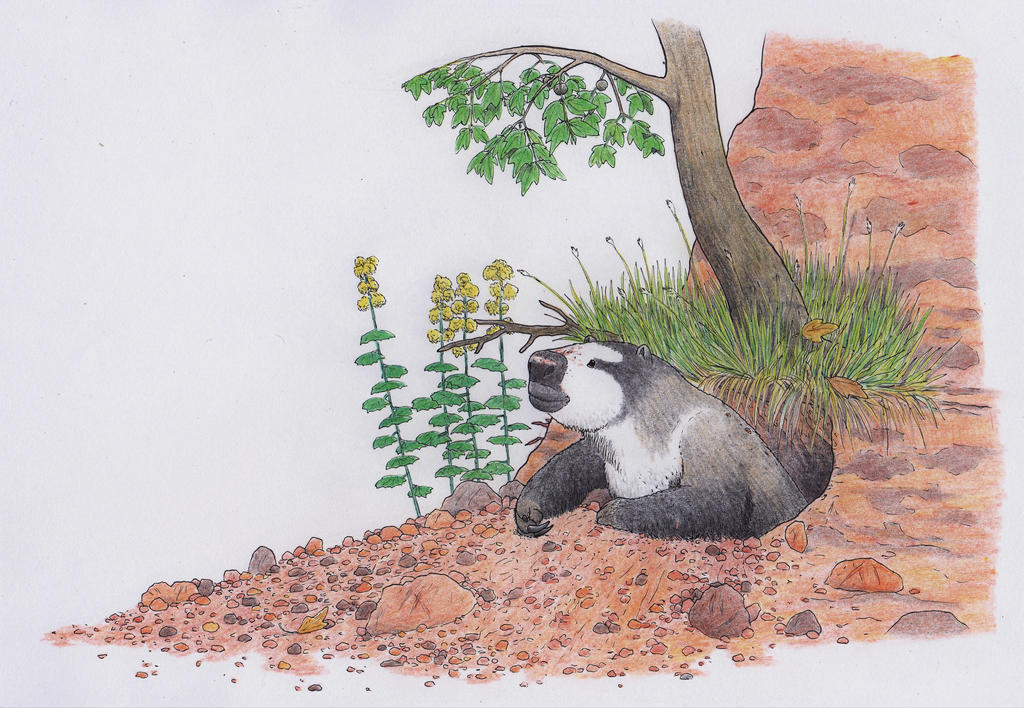ShopDreamUp AI ArtDreamUp
Deviation Actions
Description
A giant hole at the bottom of a steep slope makes clear it's not a rabbit who dug this. The hottest moment of the day has just passed and the temperatures are starting to become a bit more tolerable in Argentina.
Suddenly some muffled sniffling is heard from out of the burrow, something is thinking about coming out. First the tip of a large nose appears, carefully smelling the air to check if there aren't any predators around. When it's clear things are safe, a head rises from the darkness, a little bit sleepy the small eyes squint at the bright daylight. After two minutes the animal decides to leave and go search for some food. It's a ground sloth, a Glossotherium.
Glossotherium robustum had a length of four meters and weighed about a ton. Big, but not that big for ground sloths. Remains have been found in South America. The oldest species, G. chapadmalense, dates from the Pliocene, but G. robustus (here depicted) is from the Pleistocene. Special about these animals is that they were fossorial, they dug burrows and digging is something they were good at: some burrows are even made in sandstone!
The reason why they dug their burrows was likely because of two reasons. The first is predation and the second protection from the weather. Xenarthra are more primitive than your average placentals and aren't so good in keeping their own thermoregulation stable. During heat or cold the burrows offered a stable temperature to stay in. This explains why for example the ground sloth Megalonyx was able to survive in Alaska. Of course no burrows are found there, but it makes sense since the soil isn't as stable there and these burrows probably collapsed and disappeared after the animals went extinct.
The local wildlife most likely took advantage of these ground sloth burrows too. Glyptodont remains for example were found in one burrow (they couldn't dig themselves) and smaller animals like armadillos, bats and other creatures were probably regular visitors of these Pleistocene hotels. Also the burrows were used over generations apparently, because they are deepened episodically their structure shows. They must've played an important role for the local ecosystems.
Suddenly some muffled sniffling is heard from out of the burrow, something is thinking about coming out. First the tip of a large nose appears, carefully smelling the air to check if there aren't any predators around. When it's clear things are safe, a head rises from the darkness, a little bit sleepy the small eyes squint at the bright daylight. After two minutes the animal decides to leave and go search for some food. It's a ground sloth, a Glossotherium.
Glossotherium robustum had a length of four meters and weighed about a ton. Big, but not that big for ground sloths. Remains have been found in South America. The oldest species, G. chapadmalense, dates from the Pliocene, but G. robustus (here depicted) is from the Pleistocene. Special about these animals is that they were fossorial, they dug burrows and digging is something they were good at: some burrows are even made in sandstone!
The reason why they dug their burrows was likely because of two reasons. The first is predation and the second protection from the weather. Xenarthra are more primitive than your average placentals and aren't so good in keeping their own thermoregulation stable. During heat or cold the burrows offered a stable temperature to stay in. This explains why for example the ground sloth Megalonyx was able to survive in Alaska. Of course no burrows are found there, but it makes sense since the soil isn't as stable there and these burrows probably collapsed and disappeared after the animals went extinct.
The local wildlife most likely took advantage of these ground sloth burrows too. Glyptodont remains for example were found in one burrow (they couldn't dig themselves) and smaller animals like armadillos, bats and other creatures were probably regular visitors of these Pleistocene hotels. Also the burrows were used over generations apparently, because they are deepened episodically their structure shows. They must've played an important role for the local ecosystems.
Image size
3332x2301px 2.74 MB
Make
Canon
Model
MG5200 series
© 2016 - 2024 Dontknowwhattodraw94
Comments135
Join the community to add your comment. Already a deviant? Log In
An prehistoric Groundhog



































